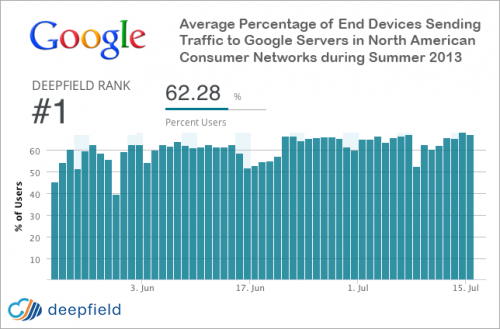July 23, 2013 weblog
Google sits on Internet-traffic throne, says report

The stats are in. According to Deepfield, an Internet analytics business, Google serves 25 percent of North American Internet traffic. The question becomes, glass half empty or full and overflowing?
How impressive is that share of 25 percent of Internet traffic for searches, web apps and video headed to and from Google's servers each day? Craig Labovitz, Deepfield CEO, discussed the results of its study in his blog on Monday, with the message that "Sometime over the last month, Google quietly broke an Internet record." Based on measurements of end device and user audience share, he added, Google is now bigger than Facebook, Netflix and Twitter combined.
That's a very full glass. Labovitz called the Google traffic rise "astounding." He added that 60 percent of all Internet end devices/users exchange traffic with Google servers during the course of an average day.
The analysis included not only computers and mobile device but varieties of game consoles, home media appliances, and other embedded devices The firm said that Google's device share is even much larger if only taking computers and mobile devices into account.
Especially interesting are comparative figures. There was a significant traffic surge in the past several years. In 2010, Google's services accounted for about 6 percent of Internet traffic.

A number of Google watchers outside Deepfield offered their ideas about why Google won 25 percent. The rise in online video has affected network data traffic and it is well known that Google acquired YouTube in 2006. Another reason offered is the increase in mobile device users who embrace an always-on, always Internet-connected lifestyle, and having many choices in form factors from smartphones to notebooks to tablets.
Nonetheless, to headline a story that Google is big in 2013 would be laughable, like telling people that it snows in Buffalo. The Deepfield exercise, though, is not laughable as the blog comments on Monday are helpful toward understanding the extent of Google's presence in the Web infrastructure, which Deerfield said has significant implications on network design and evolution.
While all eyes have been on the data center buildouts, said Labovitz, "Google has been placing servers in strategic locations outside of their traditional data centers." Google has expanded from building data centers to generating a presence of Google servers embedded everywhere in the network as part of infrastructure.
Labovitz thought that by far the most striking change in Google's presence is in deploying thousands of Google servers in Internet providers around the world. Google, he said, has deployed Google Global Cache (GGC) servers in the majority of US Internet providers. That is a notable step because in 2010 Deepfield saw GGC deployments mostly in Asia, Africa and Latin America.
Google explains its GGC program as designed to let network operators and Internet service providers deploy a small number of Google servers inside their network to serve popular Google content. Google's traffic management system directs users to the node that will provide the best performance for the user. Targeted deployment can reduce the number of route-miles traveled on an operator's network to serve Google traffic, further increasing cost savings for the operator.
More information: www.deepfield.net/2013/07/goog … -new-internet-record
© 2013 Phys.org



















